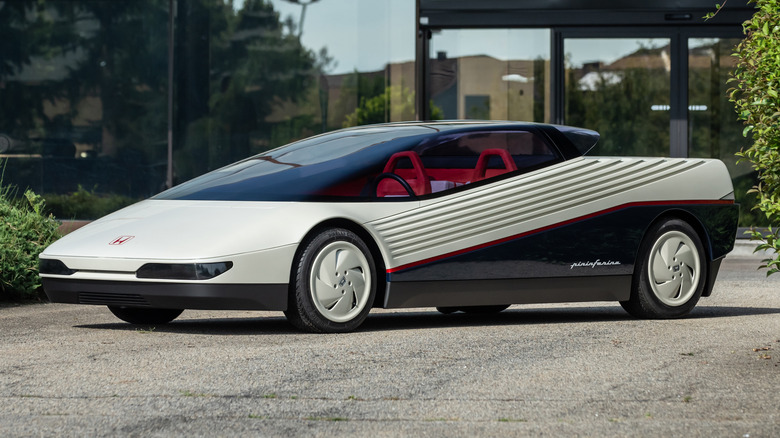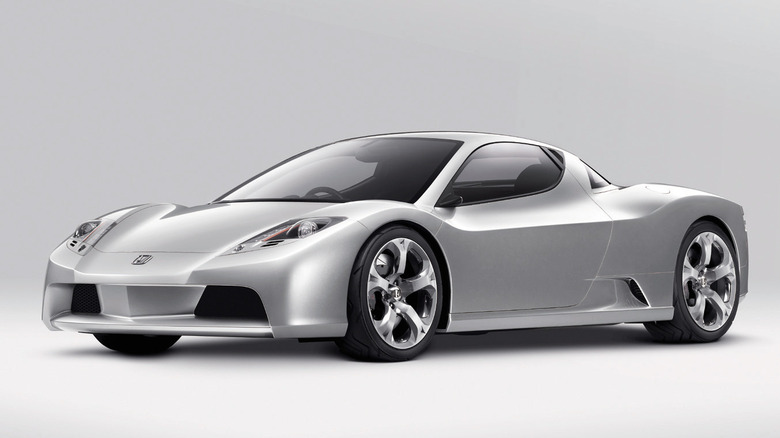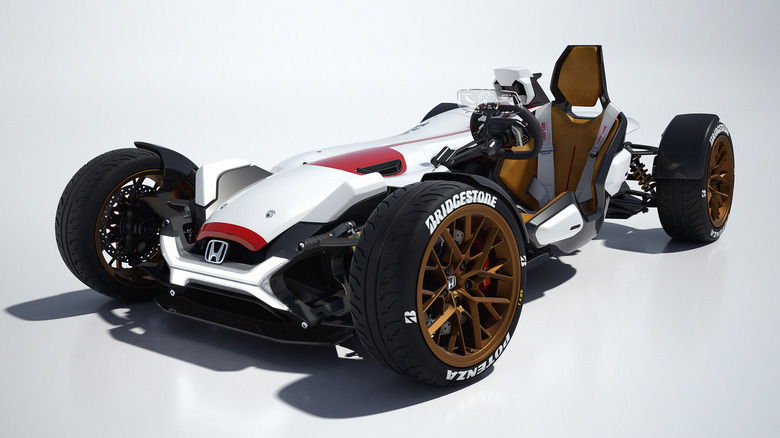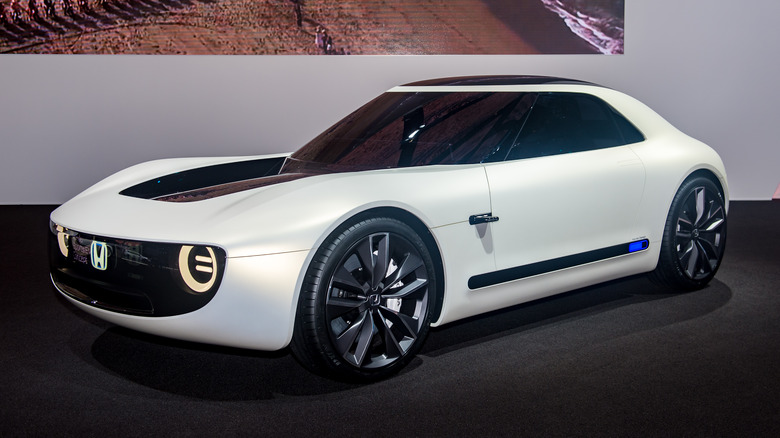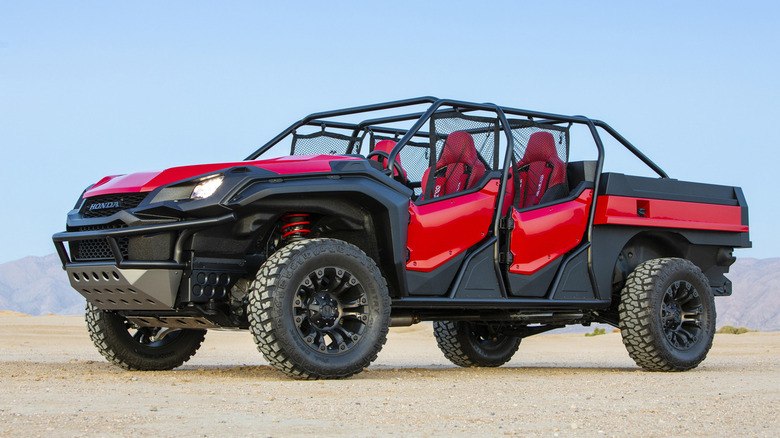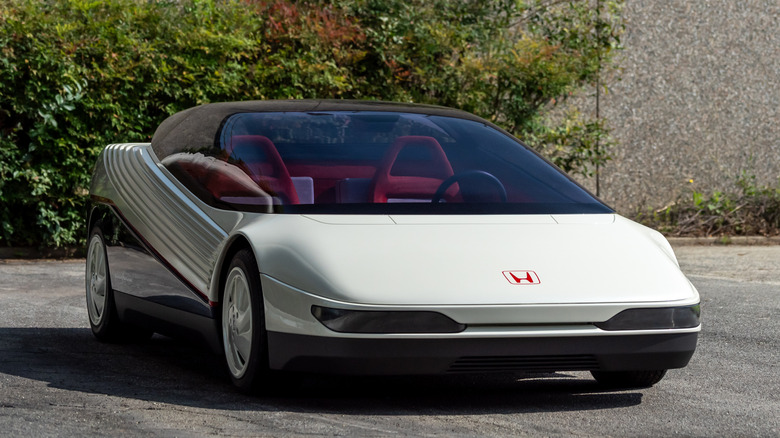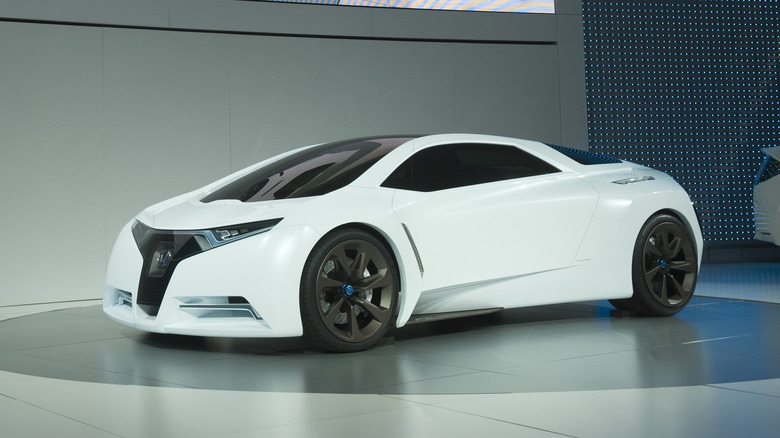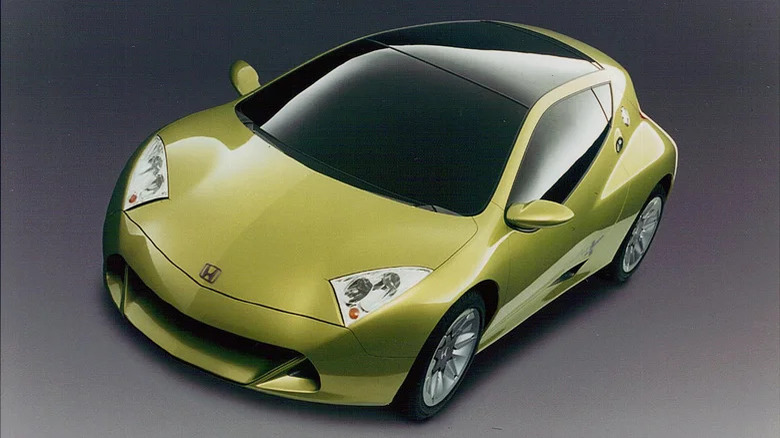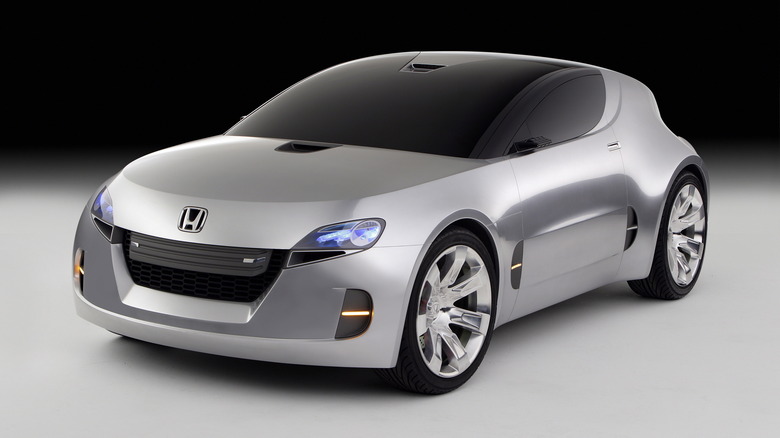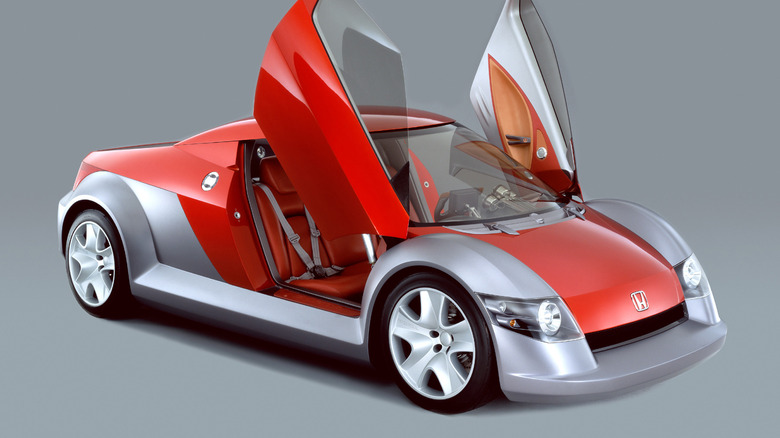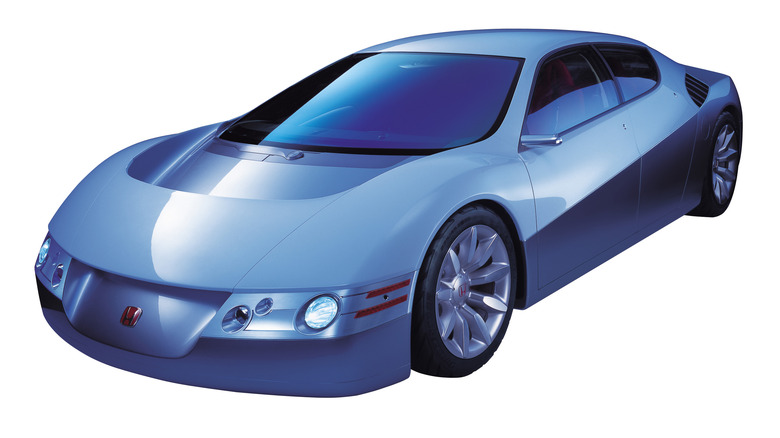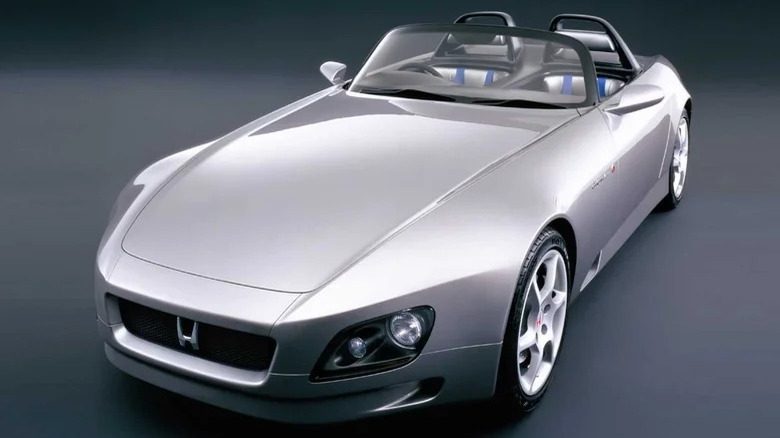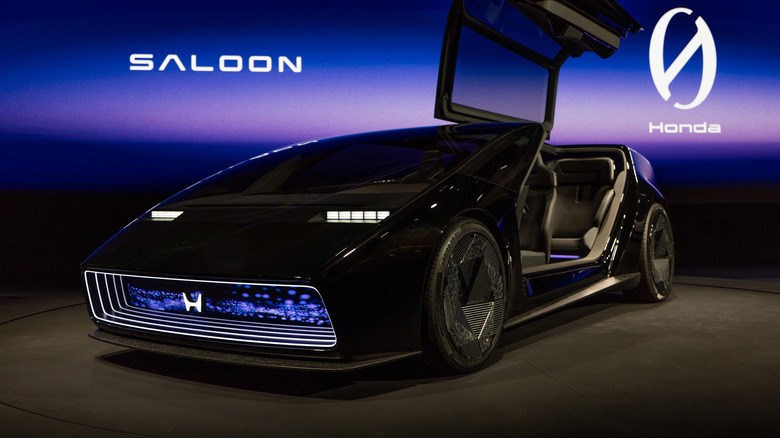The Coolest Concept Cars Honda's Ever Revealed
Honda's back catalog of concept cars is not a particularly large one — the brand only unveiled its first concept car in 1984, and since then, has released them in smaller numbers than rival manufacturers. However, when the brand does unveil a concept, there's a good chance that it will feature either pioneering technology, a cutting-edge design, or both.
The automaker has shown off more than its fair share of cool ideas over the years, many of which end up incorporated into production cars in some form. Even those that didn't often still proved influential, both to Honda's own production cars and sometimes to other manufacturers too.
From dramatically styled off-roaders to track day toys powered by racing bike engines, there's a whole lot to unpack in Honda's concept car archive. The below are among the brand's best concepts to date, with some eventually evolving into production cars and others ending up as long-forgotten gems.
Honda/Acura HSC Concept
By the time the HSC Concept was unveiled in 2003, the production NSX was already getting long in the tooth. It would survive for another few years, but was eventually axed without an immediate successor. It originally seemed like that wouldn't be the case, as the HSC's NSX-like layout and powertrain meant that many saw the concept as a preview of the next generation Honda supercar.
The HSC featured a mid-mounted 3.5L V6 engine and a long list of racing inspired design elements, including a paddle-shift automatic transmission. Its body panels were constructed from carbon fiber and its chassis was aluminum to keep weight to a minimum. Then, there was its styling, which clearly took inspiration from the NSX, although it featured distinctive new headlights and taillights.
It's not known exactly why Honda decided not to press ahead with producing a successor to the NSX despite seemingly having done all the hard work with regards to designing it. Either way, a production version of the HSC never surfaced, and it would take until 2016 for the second generation to arrive.
Honda Project 2&4
Every year, Honda holds an annual design competition where its in-house teams are encouraged to create ideas that are free from the restrictions of conventional car design. In 2015, the winning design became an official Honda concept, christened the Project 2&4. It aimed to combine the best bits of a car and a motorcycle while showing off Honda's engine-making expertise. The engine in the concept was a RC213V V4 racing motorcycle engine originally built for the brand's MotoGP racers. It had been adapted for road use in the Project 2&4, but still featured a sky-high 14,000 rpm redline.
The car's 215 horsepower output might not sound like much in the context of today's performance cars, but given its lightweight, racing-inspired design, it would have been enough to make the car a rocket on the road. Honda noted that the design took influence from the RA272 F1 car of the '60s, although the Project 2&4's seating position is even more extreme than the classic racer. In the concept, the driver's seat hangs on the outside of the car, "floating" above the ground in the spirit of a racing bike.
Honda Sports EV Concept
The majority of performance-oriented EVs on the market today are big and heavy, but in 2017, Honda unveiled a very different vision of what an EV sports car could look like. The Sports EV Concept was unveiled alongside the hatchback Urban EV Concept, and both featured a new design language that prioritized aerodynamics while giving each car a retro-modern charm. Few powertrain specifics were disclosed apart from the fact that the concept would run on all-electric power and was built on a dedicated platform.
At the time, it was speculated that the car might be a preview of an upcoming Honda sports car, but to date, no production version has been unveiled. The design language was transferred to the production Honda e city car, although that car was short-lived and never launched in America. The e's popularity was limited due to its modest range, which independent reviewers confirmed was anywhere between 90 and 120 miles depending on driving habits. Assuming a production version of the Sports EV Concept would have been based on the same platform, it seems likely it would have suffered from the same range issue, so perhaps it shouldn't be surprising that it never made it to dealerships.
Honda Rugged Open Air Vehicle Concept
Although it's very different to anything in Honda's production lineup, the Rugged Open Air Vehicle Concept borrowed most of its components from the brand's existing parts bin. It was unveiled at SEMA in 2018, and described by Honda as a cross between a pickup truck and a side-by-side. Accordingly, most of its parts were sourced from either the production Ridgeline or the Pioneer 1000.
The chassis and suspension were borrowed from the Ridgeline, giving the concept a much more imposing stature than the average side-by-side. Some of the bodywork was plucked directly from the production Pioneer 1000, and the rest was custom built. The seats were borrowed from the Civic Type R, but reupholstered in a waterproof material to withstand repeated off-road use. Honda's intention was never to bring the vehicle to dealerships — it was described at launch as a "physical thought exercise" — but a Jeep Wrangler-rivaling production version would have been cool to see nonetheless.
Honda HP-X
Honda was toying with the idea of making a supercar for many years before the original NSX was unveiled, and the HP-X was one of the earliest proposals. Honda considers the HP-X to be its first official concept car, and restored it in time for the 2024 Pebble Beach Concours d'Elegance to celebrate the 40th anniversary of its unveiling. The concept was created by Pininfarina, with its distinctive wedge shape being a world away from any previous car to wear a Honda badge.
There are some similarities between the HP-X and the production NSX — both feature a mid-mounted V6 engine, with the HP-X's engine being derived from Honda's F2 racing program. The concept also featured plenty of technology that was advanced for the era, including an early GPS system. One feature that unsurprisingly didn't make it over to the production supercar was the HP-X's single-piece canopy, which opened upwards to allow the driver entry to the cabin. The HP-X marked the first time that Honda and Pininfarina had worked together on a concept, but it wasn't the last. The two would also later collaborate on the SSM concept, which would evolve into the production S2000.
Honda FC Sport Concept
While EVs have taken precedence as the zero emissions vehicles of choice in the modern market, it wasn't always guaranteed to be that way. Honda was one of the earliest proponents of hydrogen fuel cell powertrains, and was the first manufacturer to offer hydrogen-powered cars in its dealerships. It began production of its hydrogen FCX Clarity sedan in 2008, and the same year unveiled the FC Sport Concept as a showcase of what its hydrogen technology was capable of.
The concept was designed to straddle the line between sports car and supercar, with Honda claiming it offered "supercar levels of performance" without citing specific figures. It drew on the aerodynamic expertise developed for the brand's F1 program and featured an unusual three seat layout, much like the McLaren F1. The driver sat in the center of the car and a passenger seat was fitted either side, with passengers sitting slightly further back in the cabin. The car showcased its hydrogen technology proudly, with a transparent panel at the rear of the car displaying its dual hydrogen storage tanks.
Despite several more automakers launching production hydrogen vehicles in the years since the concept was unveiled, the technology has remained niche and suffers from a chronic lack of refueling infrastructure. Without serious investment in that infrastructure, it seems unlikely that a production hydrogen sports car could ever be brought to market.
Honda JV-X
The idea of a hybrid sports car is no longer an unusual one, but back when the Honda JV-X was first unveiled, it was still a novel idea. The concept debuted at the Tokyo Motor Show in 1997 as one of four "J-Mover" cars, with the other three being the J-WJ, J-MJ, and J-MW. The J-WJ morphed into the production HR-V crossover and the J-MW became the production Capa. The J-MJ never reached production, although there are some similarities between it and the production Element, which just leaves the J-VX.
Unfortunately, Honda decided that the idea of a hybrid sports car was too exciting, and abandoned the idea. It instead put the technology in the much less exciting Insight. The 1.0L engine and electric motor from the J-VX was carried over, but the sports car body was ditched. It wasn't the end for the JV-X though, as in 2006, Honda modified the car slightly and relaunched it as the GRX concept. In turn, that concept would influence the production CR-Z, although the latter looks a lot less exotic than the original J-VX.
Honda REMIX Concept
Practicality is a key element of all Honda cars, even its sports cars. The REMIX Concept honed in on that theme, with Honda touting its luggage space as a key selling point alongside its driving experience. The brand was keen to stress that the concept was only a design study, but it was based on a compact front-wheel-drive platform and featured a four-cylinder engine, much like the production Civic. Honda had previously produced a Civic-based sports car in the form of the CR-X, but this time around, there would be no production variant.
The REMIX Concept's styling was influenced by fighter jets, particularly the large wrap-around canopy. Unlike some of Honda's other concepts, the REMIX Concept was a non-functional clay model, which gave its designers a little more freedom when it came to its styling. It's unlikely that such a canopy could have made it to production even if Honda was intent on putting the car in dealerships, although it would have certainly turned heads if it did.
Honda Spocket
Japanese automakers experimented with all kinds of strange car combinations during the '90s, resulting in collectible oddities like the Subaru SVX and Toyota Classic. One idea that didn't make it to production was the Honda Spocket, a small sports car with a pickup truck bed and scissor doors. When it was unveiled at the Tokyo Motor Show in 1999, Honda referred to it as a "crossover," although it's a long way from the many cookie-cutter crossovers of today.
The Spocket also featured a hybrid powertrain, a removable roof, and a yoke instead of a steering wheel — in other words, as many unconventional ideas as Honda could feasibly fit into one car. The concept wasn't functional, but could have borrowed Honda's existing hybrid drivetrain technology had it made production. Of course, it didn't, and so enthusiasts will forever be deprived of the chance to own a Honda pickup with Lambo doors. That's a shame, especially since so many other wacky Japanese cars from the era did end up in dealerships.
Honda Dualnote
The Dualnote was another of Honda's hybrid sports car experiments, debuting in 2001 with an electrically-assisted 3.5L V6 engine under the hood. Previous Honda hybrids mostly sported modest power outputs, but the automaker claimed the Dualnote produced around 400 horsepower. For context, that put it on par with the Ferrari 360 Modena of the same year. Except, this was a hybrid four-door Honda with a claimed fuel efficiency of around 42 mpg.
The concept's interior was just as futuristic, featuring a built-in night vision system to alert the driver to pedestrians at night and an infotainment system with a built-in web browser. Perhaps the only weak spot of the concept is its styling, particularly its headlights, which haven't aged well. Other than that, there's little to dislike about Honda's vision of the hybrid sports car future. The Dualnote was only intended as a design showcase, and so a production version was never planned, although much of the technology featured in the concept later trickled down to production vehicles.
Honda SSM
The Honda SSM will look familiar to most Honda enthusiasts, as it's an early interpretation of the design that would eventually become the S2000 roadster. It was styled by Pininfarina, and featured an inline-5 engine. Thanks to the positive reception the concept received, Honda considered it for production in its original form, but eventually decided to swap the engine out for a four-cylinder unit that it already had in development. The styling was also refined, with the production car losing the distinctive nose of the SSM.
The concept's original transmission was also changed on the road to production, although for many enthusiasts, the change was a positive one. The SSM originally featured a five-speed automatic that was borrowed from the NSX, but the S2000 launched with a six-speed manual as standard. The S2000 would eventually remain in production for a decade and become an icon in its own right, but it might never have been were it not for the SSM.
Honda 0 Series Saloon Concept
Honda unveiled the 0 Series Saloon Concept at the start of 2024, and claims that the car previews the design language of its next generation of EVs. A production version of the car will reportedly arrive in 2026, with a North American launch planned. The concept's wedge shape is a dramatic departure from the styling of its current production EV, the Prologue SUV, but given the latter's generic looks, that's arguably a good thing.
The wedge shape of the 0 Series Saloon Concept looks a little like the Kiwami concept of 2003, but Honda's history of making wedge shaped cars goes back even further to the HP-X concept of 1984. It remains to be seen how much of the original design will be carried into production — hopefully the large, screen-laden "mouth" of the concept car is toned down a bit — but it certainly seems Honda is intent on shedding its reputation for conservative styling with its latest models.
